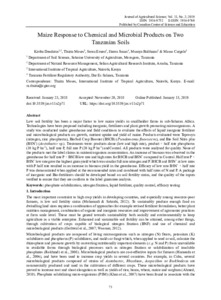| dc.contributor.author | Kiriba, D. |
| dc.contributor.author | Thuita, M. |
| dc.contributor.author | Semu, E. |
| dc.contributor.author | Ikerra, S. |
| dc.contributor.author | Msanya, B. |
| dc.contributor.author | Masso, C. |
| dc.date.accessioned | 2019-12-04T11:30:06Z |
| dc.date.available | 2019-12-04T11:30:06Z |
| dc.date.issued | 2019-01-15 |
| dc.identifier.citation | Kiriba, D., Thuita, M., Semu, E., Ikerra, S., Msanya, B. & Masso, C. (2019). Maize response to chemical and microbial products on two Tanzanian soils. Journal of Agricultural Science, 11(2), 71-81. |
| dc.identifier.issn | 1916-9752 |
| dc.identifier.uri | https://hdl.handle.net/20.500.12478/5191 |
| dc.description | Open Access Journal |
| dc.description.abstract | Low soil fertility has been a major factor to low maize yields in smallholder farms in sub-Saharan Africa. Technologies have been proposed including inorganic, fertilizers and plant growth promoting microorganisms. A study was conducted under greenhouse and field conditions to evaluate the effects of liquid inorganic fertilizer and microbiological products on growth, nutrient uptake and yield of maize. Products evaluated were Teprosyn (nitrogen, zinc phosphorus), BioSoil Crop Booster (BSCB) (Pseudomonas fluorescens), and Bio Soil Nitro plus (BSN+) (Acetobacter sp.). Treatments were: products alone (low and high rate), product + half rate phosphorus (10 kg P ha-1), half rate P, full rate P (20 kg P ha-1) and Control. All products were analysed for quality. None of the products met the label claims in nutrient/organism concentration. An increase of biomass was observed in the greenhouse for half rate P + BSCB low rate and high rates for BSCB and BSN+ compared to Control. Half rate P + BSN+ low rate gave the highest grain yield which was similar full rate nitrogen and P. BSCB and BSN+ at low rates with P half rate resulted in an increase in biomass yield in the greenhouse. Efficacy of low rate BSN+ + half rate P was demonstrated when applied at the recommended rates and combined with half rates of N and P. A package of inorganic and Bio-fertilizers should be developed based on soil fertility status, and the quality of the inputs verified to ensure that they are conform to the label guarantee analysis. |
| dc.description.sponsorship | Bill & Melinda Gates Foundation |
| dc.format.extent | 71-81 |
| dc.language.iso | en |
| dc.rights | CC-BY-4.0 |
| dc.subject | Phosphate |
| dc.subject | Solubilization |
| dc.subject | Nitrogen Fixation |
| dc.subject | Liquid Fertilizer |
| dc.subject | Quality Control |
| dc.subject | Testing |
| dc.subject | Inorganic |
| dc.subject | Soil Fertility |
| dc.title | Maize response to chemical and microbial products on two Tanzanian soils |
| dc.type | Journal Article |
| dc.description.version | Peer Review |
| cg.contributor.crp | Roots, Tubers and Bananas |
| cg.contributor.crp | Grain Legumes |
| cg.contributor.affiliation | Sokoine University of Agriculture |
| cg.contributor.affiliation | International Institute of Tropical Agriculture |
| cg.contributor.affiliation | Tanzania Fertilizer Regulatory Authority |
| cg.coverage.region | Africa |
| cg.coverage.region | East Africa |
| cg.coverage.country | Tanzania |
| cg.creator.identifier | Moses Thuita: 0000-0002-6731-9492 |
| cg.creator.identifier | Cargele Masso: 0000-0002-3980-6832 |
| cg.researchtheme | NATURAL RESOURCE MANAGEMENT |
| cg.authorship.types | CGIAR and developing country institute |
| cg.iitasubject | Natural Resource Management |
| cg.iitasubject | Soil Fertility |
| cg.journal | Journal of Agricultural Science |
| cg.howpublished | Formally Published |
| cg.accessibilitystatus | Open Access |
| local.dspaceid | 102814 |
| cg.targetaudience | Scientists |
| cg.identifier.doi | https://dx.doi.org/10.5539/jas.v11n2p71 |

